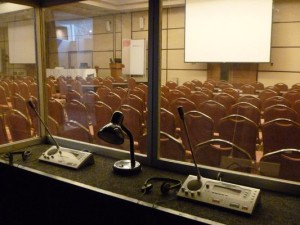Equipment Used for Simultaneous Interpretation

Simultaneous interpretation is usually contrasted with consecutive interpretation. That said, the adjective “simultaneous” may be a misnomer in that, although the interpreter is still in the booth wearing headphones and speaking into a mic, the interpreter needs to wait until the sentence is understood and processed before interpreting.
Nonetheless, a simultaneous interpreter is listening and translating one idea out loud while parsing the next. Simultaneous interpretation is actually seen as more challenging because any impediment to fluid translation, (e.g., searching for a language’s countervailing idiom) means missing out on the next idea, lagging behind and ultimately not performing well.
Simultaneous Interpretation’s Tools of the Trade
Soundproof Booths
Industry insiders say that over 5,000 business and governmental conferences take place around the world every year. This puts a high premium on simultaneous interpreters having the right equipment from the start. Perhaps a starting point is having an interpretation booth that conforms to ISO standards. ISO standard booths furnish simultaneous interpreters with the best acoustic environment for many languages spoken simultaneously.
The best booths are also designed to provide clear visuals and two-way communication. A well-designed booth will have low operation costs, flexibility, require hardly any assembly and the ability to be expanded and connected later. High-end booths should feature: double plexiglass, air conditioning, lighting systems and soundproof flooring.
Interpretation Systems
Some of the basic features that all simultaneous interpretation systems should have are: a monitoring unit, microphone headset, transmitter, receivers with headsets and all necessary cables. A compact monitoring unit ensures that two interpreters can, in turn, listen to the presenter and convey the information to the other interpreter. Using the equipment in this manner increases concentration and competency.
Even the most affordable interpretation systems will start at around 250,000 square feet of coverage. This means that simultaneous interpreters will be covered for community groups, church convocations and extensive focus groups. For larger events, simultaneous interpreters will require wireless microphones; ideally, one handheld and one lapel-attached wireless microphone would be employed to streamline speeches as well as question-and-answer sessions.
IR Systems
For security purposes (and closely adjacent rooms) an IR system might be the best solution vs. an FM system. High-end IR systems will feature relay interpretation and separate volume and tone controls for two or more interpreters working together. Also, two or more microphones in an IR system allows smooth transitions among interpreters.
Another factor to consider with an IR system is that the infrared is unable to penetrate walls; therefore, an IR system with infrared capabilities is ideal for a high-level political setting. This is so because of the added security and diminished crosstalk that infrared-capable IR systems possess. IR systems should feature around two dozen receivers (with headsets) as well as carrying cases and applicable cables.
PA Systems
Especially for smaller venues, simultaneous interpreters require a field mixer, PA system or wireless microphones. Lapel and hand-held microphones are essential for wireless microphone packages. Also, field mixers can help ensure that translations sound crisp and clear, streamlining the transmission process.
Encrypted Systems
For added security, consider an encrypted, two-way listening system. The administrator can, in essence, lock-in volume and tone controls with a four-digit security key. This helps prevent last-second changes or accidents during simultaneous interpretation. These encrypted systems are usually harmonized to prevent interference as well.






